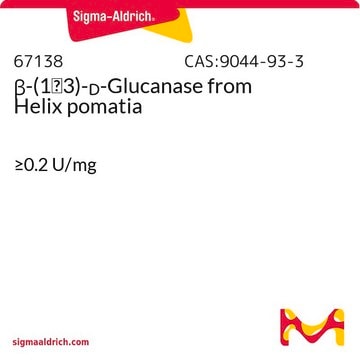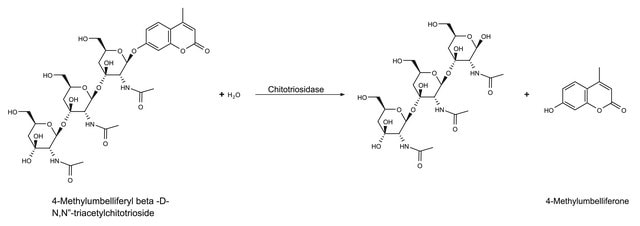C6137
Chitinase from Streptomyces griseus
lyophilized powder (essentially salt free), ≥200 units/g solid
Synonim(y):
N-acetyl-glucosaminidasechitobiase, Chitin digestion enzymes, poly(β-(1→4)-[2-acetamido-2-deoxy-D-glucoside])- glycanohydrolase
About This Item
Polecane produkty
Postać
lyophilized powder (essentially salt free)
Poziom jakości
aktywność właściwa
≥200 units/g solid
masa cząsteczkowa
30 kDa
rozpuszczalność
H2O: soluble 0.90-1.10 mg/mL
temp. przechowywania
−20°C
Szukasz podobnych produktów? Odwiedź Przewodnik dotyczący porównywania produktów
Powiązane kategorie
Opis ogólny
The enzymatic hydrolysis of chitin to N-acetyl-D-glucosamine involves two consecutive enzyme reactions:
- The first reaction, chitodextrinase-chitinase, is a poly(β-(1→4)-[2-acetamido-2-deoxy-D-glucoside])- glycanohydrolase, which removes chitobiose units from chitin.
- The second activity is N-acetyl-glucosaminidasechitobiase, which cleaves the disaccharide to its monomer subunits, N-acetyl-D-glucosamine.
Zastosowanie
Human health care: Asthma.
Pharma: preparation of chitooligosaccharides and N-acetyl D glucosamine,
Preparation of single-cell protein
Isolation of protoplasts from fungi and yeast
Control of pathogenic fungi
Treatment of chitinous waste, mosquito control and morphogenesis
Działania biochem./fizjol.
Cechy i korzyści
Definicja jednostki
One new 1 hour unit = approx. 50 old 48 hour units.
substrat
Hasło ostrzegawcze
Danger
Zwroty wskazujące rodzaj zagrożenia
Zwroty wskazujące środki ostrożności
Klasyfikacja zagrożeń
Resp. Sens. 1
Kod klasy składowania
11 - Combustible Solids
Klasa zagrożenia wodnego (WGK)
WGK 3
Temperatura zapłonu (°F)
Not applicable
Temperatura zapłonu (°C)
Not applicable
Środki ochrony indywidualnej
Eyeshields, Gloves, type N95 (US)
Certyfikaty analizy (CoA)
Poszukaj Certyfikaty analizy (CoA), wpisując numer partii/serii produktów. Numery serii i partii można znaleźć na etykiecie produktu po słowach „seria” lub „partia”.
Masz już ten produkt?
Dokumenty związane z niedawno zakupionymi produktami zostały zamieszczone w Bibliotece dokumentów.
Klienci oglądali również te produkty
Powiązane treści
Find cell lysis and protein extraction reagents like cell lysis buffers, protein extraction kits, extraction enzymes, and other lysis enhancers for isolating and purifying proteins.
Znajdź odczynniki do lizy komórek i ekstrakcji białek, takie jak bufory do lizy komórek, zestawy do ekstrakcji białek, enzymy ekstrakcyjne i inne środki wspomagające lizę do izolacji i oczyszczania białek.
Metody lizy komórek i ekstrakcji białek obejmują przegląd różnych technik, od rozpuszczania detergentami po mechaniczne rozbijanie, wspierając potrzeby badawcze.
Cell lysis and protein extraction methods overview various techniques, from detergent solubilization to mechanical disruption, supporting research needs.
Nasz zespół naukowców ma doświadczenie we wszystkich obszarach badań, w tym w naukach przyrodniczych, materiałoznawstwie, syntezie chemicznej, chromatografii, analityce i wielu innych dziedzinach.
Skontaktuj się z zespołem ds. pomocy technicznej










